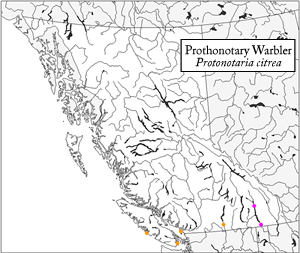Adult male
The back and scapulars are olive-green; the rump and uppertail coverts are blue-grey. The wings are blue-grey with olive-green lesser upperwing coverts. The relatively short, square-tipped tailed is black with blue-grey outer feather edges and large white patches on the inner webs of all but the central pair of feathers. The entire head, breast, belly, and flanks are bright golden-yellow, fading to white on the lower belly and undertail coverts. In fresh fall plumage, the crown and nape feathers are tipped with olive-green. The iris is dark, the relatively long, slender, pointed bill is black (duller and browner during the fall and winter, with an extensive pale base to the lower mandible), and the legs and feet are dark grey. The dark eye is very prominent on the otherwise wholly bright yellow head.
Adult female
Very similar to adult male, but duller overall, with a stronger and more extensive olive-green wash on the crown, nape, and neck and slightly duller yellow on the face and underparts. The white spots in the tail feathers are smaller than those of the male. Bill slightly duller than adult male, with a paler base to the lower mandible (brown to flesh-coloured).
Immature
The immature plumage of both sexes is acquired in late summer and is held throughout the first winter. Both sexes resemble adult females, and many immature males may be indistinguishable from adult females (although most are slightly brighter than females, with larger white spots in the tail). Immature females are even more heavily washed with olive-green on the head than adult females. All immatures have a browner bill with an extensive flesh-pink base to the lower mandible.
Measurements
Total Length: 13.3-14 cm
Mass: 13.6-20 g
Source: Curson et al. (1994); Dunn and Garrett (1997); Petit (1999)
Protonotaria citrea (Boddaert, 1783)
Prothonotary Warbler
Family: Parulidae
Species account author: Jamie Fenneman
Prothonotary Warbler
Family: Parulidae
Species account author: Jamie Fenneman
Species Information
Biology
|
Habitat
|
Distribution
|
Conservation
|
Taxonomy
|
Status Information
BC Ministry of Environment: BC Species and Ecosystems Explorer--the authoritative source for conservation information in British Columbia. |

